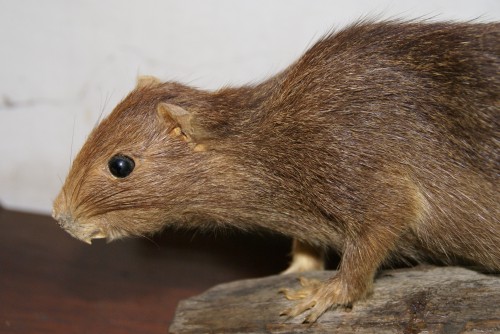The Little Earth Hutia (Mesocapromys sanfelipensis) is a very poorly known species that was first discovered in 1970 on a single tiny island, Cayo Juan Garcia, in the Cayos de San Felipe off southwestern Cuba. A large series of specimens was collected by Cuban researchers from the island during the 1970s, and the species has not been seen since 1978, when 43 individuals were taken as museum specimens. Surveys of the Cayos de San Felipe in the 1980s and 2003 found no surviving hutias, and this species may already be extinct. Classified as Critically Endangered (Possibly Extinct) on the IUCN Red List of Threatened Species.
How this species is doing
Pressure
The little earth hutia’s decline may have been caused by competition with introduced black rats and other invasive mammals, habitat loss from fires, and overhunting. Black rats were found to be very abundant on the Cayos de San Felipe in surveys conducted in the 1980s and in 2003. Intensive hunting of hutias may have occurred in the past when a military installation was established in the Cayos de San Felipe. Widespread forest clearance apparently took place on Cayo Juan Garcia in 1988-89, and Cuban fisherman still use the islands today as a temporary base, with remaining habitat being periodically damaged by accidental fires started by cooking activities. However, researchers looking for hutias in 2003 found that appropriate habitat was still present across many of the islands.
Responses
Cayo Juan Garcia is part of the Cayos de San Felipe Faunal Refuge. This species has not been seen in over 30 years and so field surveys are urgently required to investigate whether any hutias still survive on any islets in the Cayos de San Felipe and, if so, a captive breeding programme would be needed. An invasive mammal control programme is also necessary to conserve the highly threatened surviving land mammals of the Cuban offshore archipelagos.
Knowledge level
Almost nothing is known about the ecological requirements of the little earth hutia, because the species is only known from a series of museum specimens collected from Cayo Juan Garcia in the 1970s, and has never been studied alive by researchers. However, other hutia species found on Cuban offshore islands (such as the large-eared hutia Mesocapromys auritus) have narrow dietary requirements, unlike the more generalist species on mainland Cuba. Other hutia species are highly social and engage in various activities (e.g. foraging, grooming) as a group. Hutias breed year-round and have one to three litters a year, with an average litter size of one or two young. The average lifespan of most hutia species is eight to eleven years. It occurs in mangroves and low dense vegetation on Cayo Juan Garcia








